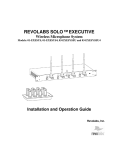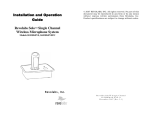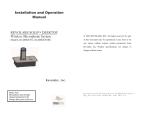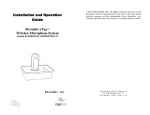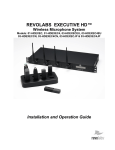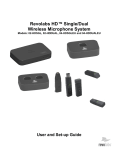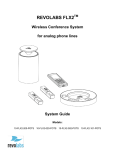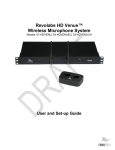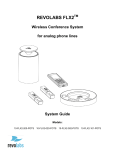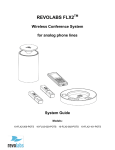Download Revolabs SOLO EXECUTIVE 03-EXESYSEU Product specifications
Transcript
Installation and Operation Manual SOLO – EXECUTIVE Wireless Microphone System (01-EXESYS and 03-EXESYSEU) © 2006 REVOLABS, INC. All rights reserved. No part of this document may be reproduced in any form or by any means without express written permission from Revolabs, Inc. Product specifications are subject to change without notice. Solo – Executive Manual 01-EXEMAN-PAP-11 Mfg. #91-8562-30N00 August 2006 (Rev 2.2) i Table of Contents Safety and General Information................................................ 2 FCC User Information ..................................................................... 2 European Compliance..................................................................... 3 Safety Compliance .......................................................................... 3 System Components ................................................................ 4 Solo Executive Charger Base................................................... 5 Power Module ................................................................................. 5 System Mute Switch........................................................................ 5 Solo Personal Microphone Modules ......................................... 5 Charging the Batteries .................................................................... 6 Using the Microphone ..................................................................... 6 Solo Executive Base Station .................................................... 7 Installation....................................................................................... 8 Connections .................................................................................... 8 Set-up ............................................................................................. 8 Pairing Wireless Microphones to Base Station ............................... 8 Pairing Charger Base to Base Station............................................. 9 System Mute Function Switch....................................................... 10 DB25 Control Port ......................................................................... 10 System Functions ......................................................................... 12 Indicator LEDs .............................................................................. 13 Warranty ................................................................................ 15 System Specifications ............................................................ 16 Safety and General Information IMPORTANT INFORMATION ON SAFE AND EFFICIENT OPERATION. READ THIS INFORMATION BEFORE USING YOUR DEVICE. FCC User Information FCC Registration Number: 0014898290 FCC ID Number: T5V01EXESYS Solo Executive Base Station FCC ID Number: T5V01EXEMIC Solo Executive Microphone FCC Notice to Users Users are not permitted to make changes or modify the equipment in any way. Changes or modifications not expressly approved by Revolabs, Inc. could void the user’s authority to operate the equipment. This device complies with Part 15 of the FCC Rules. Operation is subject to the following two conditions: (1) this device may not cause harmful interference, and (2) this device must accept any interference received, including interference that may cause undesired operation. IMPORTANT NOTE: Federal Communications Commission (FCC) Radiation Exposure Statement – This equipment complies with FCC radiation exposure limits set forth for an uncontrolled environment. Professional Installation This product must be professionally installed. Industry Canada Notice to Users Operation is subject to the following two conditions: (1) This device may not cause interference and (2) This device must accept any interference, including interference that may cause undesired operation of the device Ref IC: RSS 210 Sec. 5.11. The term “IC:” before the certification/registration number only signifies that registration was performed based on a Declaration of Conformity indicating that Industry Canada technical specifications were met. It does not imply that Industry Canada approved the equipment. See Ref IC Self-Marking 6(f) and RSP-100 Sec. 4. IC ID Number: 6455A-01EXESYS IC ID Number: 6455A-01EXEMIC Solo Executive Base Station Solo Executive Microphone Restricted use with certain medical devices Hearing Aids Some devices may interfere with some hearing aids. In the event of such interference, you may want to consult with your hearing aid manufacturer to discuss alternatives. Other Medical Devices If you use any other personal medical device, consult the manufacturer of your device to determine if it is adequately shielded from RF energy. Your physician may be able to assist you in obtaining this information. 2 Export Law Assurances This product is controlled under the export regulations of the United States of America and Canada. The Governments of the United States of America and Canada may restrict the exportation or re-exportation of this product to certain destinations. For further information contact the U.S. Department of Commerce or the Canadian Department of Foreign Affairs and International Trade. The use of wireless devices and their accessories may be prohibited or restricted in certain areas. Always obey the laws and regulations on the use of these products. 01-EXESYS North America UPCS Usage Restriction Due to the UPCS frequencies used, this product is licensed for operation only in the United States of America and Canada. 03-EXESYSEU European Union Usage Restriction Due to the frequencies used, this product is licensed for operation only in the European Union countries. European Compliance This equipment has been approved in accordance with Council Directive 1999/5/EC “Radio Equipment and telecommunications Equipment.” Conformity of the Equipment with the guidelines below is attested by the CE mark. Model Numbers: 03-EXERACEU-BLK-11 03-EXEMICEU-BLK-11 03-EXECHGEU-BLK-11 Solo Executive Base Station Solo Executive Microphone Solo Executive Charger Standards to which Conformity is declared: ETSI EN 301 489-6 v1.2.1 (2002-04) Title: Electromagnetic compatibility and Radio spectrum matters (ERM); ElectroMagnetic Compatibility (EMC) standard for radio equipment and services; Part 6: Specific conditions for Digital Enhanced Cordless Telecommunications (DECT) equipment. Safety Compliance TUV Rheinland of North America, Inc. 3 Introduction Congratulations on the purchase of a Revolabs digital wireless communication system! We are pleased that you have chosen the Solo Executive Wireless Microphone System with 1.9 GHz DECT technology. The Solo Executive provides high band-width audio from multiple wireless microphones enabling reliable, un-tethered communications in audio and video conferences. The Solo Executive Wireless Microphone System is a unique marriage of innovative technology and ergonomic stylish design. The system uses Multi-Carrier, Time Division Multiple Access and Time Division Duplex (MC/TDMA/TDD) radio transmissions both to and from the microphone. This technology allows the microphones to co-exist with other wireless products such as wireless LANs (802.11B&G), as well as allowing digital encryption technology to ensure secure communications, and eliminates “buzzing” in the audio from cell phones. System Components Your Solo Executive System package contains a rackmountable Base Station, a Charger Base and eight wireless microphones. The Base Station houses the processor and one end of the wireless connection. It has two sets of diversity antennas and provides individual line-level audio in and out for each microphone channel. This allows for additional post processing by external multi-channel equipment. The Charger Base unit stores and charges the wireless microphones when not in use. There are many features that this system provides that increase the productivity of a conference call including consistent audio input from all participants, decreased room noise, auto and manual mute, wireless encryption, re-synchronization and full duplex audio. 4 Solo Executive Charger Base The Charger Base is used for storage and charging the microphone when not in use. Microphones must be properly inserted into the base and seated flush for charging to occur. 4 1. System MUTE Switch — overrides individual Microphone mute function. 2. LED indicator — power / mute status indicator. 3. Charger Bays — charges up to 8 Microphones. 4. Line Cord Receptacle — power supply input (on rear). 2 1 3 Power Module The Charger Base requires 5VDC power. Plug the supplied AC adapter into an appropriate power outlet 110-220 AC, 50-60Hz. The power LED on the Charger Base will illuminate. System Mute Switch There is a system MUTE button on the Charger Base. In normal operation the LED will be solid GREEN (power on). In this mode, the microphone devices can individually mute themselves. Pressing the system MUTE button will mute “all” wireless microphones in the system and the Charger Base LED will turn RED. All microphones active in the system will also change to flashing RED LED status indicating muted microphone audio. To un-mute all microphones, press the system MUTE button again. The Charger Base LED will return to solid GREEN, and all microphones will return to their previous state prior to the system mute. Note: Pressing the MUTE button on a microphone while the system mute is active (solid RED LED on Charger Base) will NOT un-mute the microphone. Solo Personal Microphone Modules The wireless personal microphone modules are synchronized to the rackmounted Base Station and can be worn on the user’s shirt pocket, lapel or on a lanyard. They provide high quality full duplex audio between each user and the conferencing phone/system. This system allows attendees to step out of the conference room area and still participate in the call. 1. Mute Button — controls multiple microphone functions. 2. Charging Port — accepts the storage base battery charger. 3. LED Indicator — provides a visual status about wireless module. 4. Earpiece Jack — accepts the 2.5mm plug for the earpiece. 5. Pocket Clip — attaches microphone to user. 5 1 4 5 3 2 Charging the Batteries How to Charge 1. Place microphone(s) into the Executive Charger Base. 2. During charging, the LED indicator turns on (RED) and remains on until charging completes. The microphones are muted while in the Charger Base. In normal use, batteries should fully charge in about 2 hours, and can be “quick-charged” to 80% capacity in 45 minutes. 3. When charging completes, the LED turns off and the microphone is ready for use. Note: A fully charged module battery provides approximately 8 hours of talk time. When to Charge First-time use — before using the wireless microphones the first time, charge the self-contained battery for eight hours (or overnight) in the Charger Base. Recharging — when the yellow light starts to flash on the microphone the battery needs recharging. Over time (years), batteries gradually wear down and require longer charging times. This is normal. The Lithium Polymer rechargeable batteries that power the microphones are not user serviceable. Please contact your AV service provider for replacement instructions and to assure the proper disposal method is used. Warning: Never dispose of batteries in a fire because they may explode. Using the Microphone 1. Remove the microphone from the Charger Base. The microphones turn on and mute themselves automatically when removed from Charger Base, to reduce noise while being attached to clothing. 2. The wireless microphone has a clip on the back which allows the microphone to be easily clipped onto a shirt pocket, blouse or lapel. The microphone can also be clipped on to a lanyard and be worn around the neck. Attach the microphone to clothing or to a lanyard, as close to the mouth as possible (within 6 - 12 inches is recommended). 3. With the microphone in the wearing position, un-mute the microphone by pressing and releasing the MUTE button (confirm by viewing flashing GREEN LED). 4. To turn microphones off, return the microphone unit to the Charger Base or press and hold the MUTE button for ~10 seconds until the LED turns solid RED and release button. 5. If the microphones are moved out of range of the Base Station (~30 meters) the connection will be dropped (LED flashes all colors) and the microphone will mute. After 15 seconds the microphone will beep 5 times, and will continue beeping every 30 seconds to remind the user to return the microphone to the conference room. When the microphone is moved back into range the connection will automatically be re-established to its original state, and the beeping will cease. 6 Adjusting the Volume The volume of the microphone is set at the factory and cannot be adjusted on the wireless microphone. Access to each channel is provided on the Base Station for external amplification. Note: Moving the wireless microphone closer to the mouth will increase the volume. To change the volume on the earpiece, use the dial on the earpiece wire. Turning the dial towards the earpiece will increase the volume, and turning the dial towards the microphone will decrease the volume. Use the attached clothing clip to secure the earpiece wire. Solo Executive Base Station 4 1 2 5 3 6 7 9 8 11 12 13 14 10 1. Channel LED indicators: Displays microphone and pairing states 8. Mini-Phoenix Connectors: Audio in and out connections (8 channels in, 8 channels out) 9. Pairing LEARN Button and Signal LED: For pairing Charger Mute to Base Station 2. Diversity Antennae: Two sets 3. Pairing Push Buttons: For pairing microphones to Base Station 10. Local/remote selector switch 4. Muting Antenna 11. USB and Ethernet Ports (Future use) 5. Power On LED 12. Mini-Phoenix Connectors: Multi-base station (BUS) synchronization connector 6. On/Off Switch: Powers up unit 13. System Mute function switch 7. Power In Connector (AC In) 14. DB25 Control Port (Parallel IO Port) 7 Installation The Executive Base Station is easily installed into a standard 19” AV rack system using the supplied rack ears and standard rack screws. The equipment requires 110-220V AC, 50-60 Hz, power. Plug the power cord into an appropriate outlet and turn the circuit breaker-protected power switch on the back panel to Reset. The GREEN power LED on the front panel will illuminate. Attach the four diversity antennas (two on each side) and the system mute antenna (SMA male connector) in the center. Connections There are eight mini-phoenix input and output ports on the back panel of the unit providing access to each channel’s audio signal. The provided mini-phoenix connectors are designed for easy wiring. The three terminals (from left to right) correspond to positive +, negative −, and ground . Use the screws on top of the connector to first loosen the terminal to insert an appropriate 3 conductor cable (3 separate conductors, or 2 conductors and shield), and then tighten the screw to secure. Push the connector onto the pins centered under the desired input or output port until firmly secured. There are eight output channels representing a separate channel for each microphone. Likewise, there are eight input channels to the unit. The microphone output connectors need to be attached to the line-level input connectors of an audio mixer. The Base Station input connectors should then be attached to mixer channel outputs. Because the system is full-duplex, the input connections provide the ability to hear program audio using the provided earpiece attached to the microphone. Depending on the application, it is possible to feed a single mixed channel back to all earpieces or, alternatively, each user can receive a separate and unique channel. This would allow for translation or other services to be incorporated into an application. Set-up The Base Station has eight indicator LEDs (one for each channel) and pairing push buttons on the front panel. When the LED is flashing GREEN or RED, that channel is active and connected to a wireless microphone (GREEN is for live audio, RED is for muted). When the LED is off, the channel is inactive (the microphone is out of range or turned off). The front panel also has two sets of diversity antennae for best reception, and a fifth antenna for system mute reception. These antennae are removable for relocation by installation professionals, based on the installation environment and coverage optimization requirements. Pairing Wireless Microphones to Base Station “Pairing” creates a link between the wireless microphone and the Base Station with a unique electronic serial number. When the microphone and Base Station have been previously paired, the microphone will automatically try to connect to the Base Station whenever it is lifted from the Charger Base. Remember, microphones are always muted (flashing RED LED) when they are removed from the Charger Base and the MUTE button needs to be pressed to make it “live” (flashing GREEN LED). Microphones in new systems come paired to the Base Station with each microphone assigned to a unique channel on the base unit. However, if a replacement microphone is ever required, it will need to be manually “paired.” 8 If a microphone is lifted from the Charger Base and the LEDs continuously flash alternating RED and GREEN, and/or the Base Station LED flashes alternating RED and GREEN, the microphone needs to be paired to the system. Make sure that all other microphones are properly paired, and that the Base Station is powered on, before proceeding to pair an individual microphone. By noting which microphone channels are already in use (paired), it will be obvious which channel to use for pairing the microphone. Microphone Pairing Instructions 1. First make sure the microphone is turned OFF (no LED activity). If the unit is ON, press and hold the MUTE button for 10 seconds until the LED turns solid RED (do not release when you hear two beeps). Release the button to turn the unit off. 2. Next, place the microphone unit into pairing mode by holding the MUTE button down for seven seconds. The LED will turn solid GREEN and then solid RED. Release the MUTE button. The microphone unit is now in pairing mode. 3. Within one minute, push and hold the button for the desired channel on the Base Station for seven seconds to enter into pairing mode. The LED for that channel will be solid RED until pairing starts, as indicated by Solid RED followed by a quick GREEN flash, then switching to flashing RED on both the microphone and the Base Station (muted audio). Pairing is now complete. Pairing Charger Base to Base Station “Pairing” is also used to create a link between the Charger Base system MUTE control and the Base Station. When the Charger Base and Base Station are paired, the system mute function may be used. The Charger Base in new systems come paired to the Base Station. However, if a replacement Charger Base is ever required, it will need to be manually “paired.” System Mute Button Pairing Instructions 1. First, power-on the Charger Base and Base Station (power LEDs on both units are GREEN). 2. Next, place the Base Station system into pairing mode by briefly pressing the LEARN button on the rear connection panel. The pairing LED next to the LEARN button will illuminate. 3. Now press the MUTE button on the Charger Base once. The pairing LED on the back of the Base Station panel will go off and the power LED on the Charger Base will turn solid RED. 4. Press the MUTE button on the Charger Base again. The pairing LED on the Base Station will flash twice and the power LED on the Charger Base will turn solid GREEN. 5. Once the pairing LED on the Base Station stops flashing, pairing is complete and the MUTE button on the Charger Base will mute all the microphones in the system. 9 System Mute Function Switch In certain circumstances it is preferable to use the muting capabilities in a DSP based automated microphone mixer instead of the Charger Base system mute. This is the case when the mixer is providing acoustic echo cancellation and needs a continuous signal to maintain a near-end audio reference. The two position System Mute switch located on the back panel controls how the Base Station handles the audio output for muted channels. Position 1 (left side - default): Base Station completely shuts off audio out of each channel that is in the mute state. Position 2 (right side): Base Station leaves audio output of muted channel at the same level and signals the appropriate “mute out” pin on DB25 connector for line muting on external hardware (see DB25 below). Warning: The Executive system will not mute when the switch is in Position 2 (right side). Neither the microphone MUTE button, nor the System Mute button on the Charger Base will mute audio. Muting is only controlled by the third party mixer. DB25 Control Port In connection with the System Mute switch, the DB25 Control Port allows the use of third party control systems using parallel port IO (active low, open collector). The pin-out status functions shown below can be used to provide system muting operations via third party products. The System Mute switch should be pushed all the way to the right for this feature to operate. The MUTE OUT indicators are used to determine muted channels and the SYS MUTE IN mutes all channels by using a programmable muting macro in the control device. DB25 Connector Pin Function Pin 1 Pin 2 Pin 3 Pin 5 Pin 7 Pin 9 Pin 11 Pin 13 Pin 15 Pin 25 Pin All Others Mute – Channel 1 output System Mute – Input Mute – Channel 2 output Mute – Channel 3 output Mute – Channel 4 output Mute – Channel 5 output Mute – Channel 6 output Mute – Channel 7 output Mute – Channel 8 output Ground NA Please see the operating manual for the third party control device for more information on setup and programming. 10 Using Multiple Systems If more than one Base Station is required for an area, each unit needs to be interconnected with a sync cable using the supplied mini-phoenix connector. The three terminals correspond to positive +, negative −, and ground . Use the screws on top of the connector to first loosen the terminal to insert an appropriate three conductor cable (3 conductors, or 2 conductors and shield), and then tighten the screw to secure. Push the connector onto the pins labeled BUS. Each addition system should be connected by paralleling the conductors through the phoenix terminals. For example, there would be two conductors in each of the three terminals of the second Base Station in a three Base Station system One Station needs to be set as the LOCAL (Master) unit by sliding the switch next to the BUS port to the left. The other units should remain in the REMOTE setting to the right (default position). The LOCAL unit manages the entire system and distributes microphone transmission across the available channels to maintain frequency integrity, and also coordinates system muting. Note: The switch must be in the REMOTE position for a single Base Station system. Microphones will not function if the switch is in the LOCAL position. The maximum number of systems for a given area is three 01-EXESYS in North America (24 channels) and four 03-EXESYSEU for EU (32 channels). 11 System Functions The following table shows the functions supported by the Solo Executive System: Function Base Wireless Station Microphone Status Status Enter Pairing Mode On Action Off Press the Microphone MUTE button for about 7 seconds (LED solid RED), and then press the MUTE button on the Charger Base for about 7 seconds (LED solid RED). On A short press of the Microphone MUTE button or Charger Base MUTE button causes flashing RED LED on each unit indicating that the Microphone has audio muted. Pressing either MUTE button again will un-mute Microphone (flashing GREEN LED on each unit). Mute On Turn Off Microphones On On Press and hold the Microphone MUTE button for about 10 seconds, until the LED stays solid RED, and then release. Or Dock the Microphone into the Charge Base for less than 2 seconds. Turn On Microphones Off Off Press and hold the Microphone MUTE button for about 3 seconds, until the LED shows solid GREEN. Or Dock the Microphone into the Charge Base for at least 4 seconds. 12 Indicator LEDs The following tables show activities associated with the various states shown by the LEDs: Equipment Use Microphone LED Microphone in Charger Base Microphone not in Charger Base Solid RED OFF Base Station Channel LEDs OFF OFF OFF OFF Two RED flashes every 1.5 seconds GREEN flash every 1.5 seconds Meaning Charging in Progress Charging Complete Microphone powered OFF or battery discharged RED Flashing Microphone muted GREEN Flashing Microphone “live” Pairing mode or confirmation of powering-down. Microphone pairing complete Solid RED Solid RED RED / GREEN Flashing RED Flashing Alternating slow GREEN and RED OFF or Alternating slow GREEN and RED Microphone or channel not paired YELLOW flash alternating with GREEN or two RED flashes Solid GREEN Microphone low battery Alternating RED, YELLOW, GREEN, YELLOW OFF Rapid RED flashes continuing for more than a few seconds OFF Groups of five rapid RED flashes OFF Note: The Base Station power LED will be green when power is on. 13 Searching for a connection, or out of radio range. The Microphone will try to re-establish the link for about 5 minutes, and then turn off automatically. Radio congestion – it is not possible to make a radio connection because there are already too many nearby users, or there is heavy radio interference. Possibilities include some types of digital cordless phones, and other Solo installations. Unit is faulty. Contact your AV service provider for advice. Equipment Use Microphone LED Charger Base LED Meaning Microphone in Charger Base OFF OFF Charger Base is unplugged GREEN Flashing Solid GREEN RED Flashing Solid RED Equipment Use Microphone Earpiece Microphone not in Charger Base Five rapid tones repeated every 30 seconds No audio or deteriorating audio quality Five rapid tones repeated every 20 seconds Microphone not in Charger Base Microphone is “live” Microphones muted using Charger mute Audio Indicators 14 Meaning Microphone out of range Low battery Warranty Revolabs, Inc. warrants this product to be free of manufacturing defects. Repair or replacement of any defective part or unit (at the discretion of the Seller) will be free of charge for the period of one year. Any attempt by the user to alter the equipment, or equipment damaged by negligence, accident, or Acts of God voids this warranty. The Seller shall not be liable for any consequential damage resulting from the malfunction of this product. Should the user experience unsatisfactory performance from this equipment, contact the Seller to obtain instructions for return, or replacement, as deemed necessary. This warranty is not transferable by the original end user. Revolabs, Inc. 63 Great Road Maynard, MA 01754 www.revolabs.com 15 System Specifications Dimensions, (L, W, H) and Weight Executive Base Station 16.9” (43.03 cm) x 8.0” (20.32 cm) x 1.7” (4.42 cm), 6.5 lbs (2.95 kg) Charger Base 8.3” (21.1 cm) x 4.3” (10.9 cm) x 1.0” (2.56 cm), 1.0 lb (0.45 kg) Wireless Microphones 0.9” (2.4 cm) x 0.8” (1.95 cm) x 2.6” (6.68 cm), 0.05 lb (0.01 kg) Shipping Weight 12.0 lbs (5.45 kg) Radio Frequency 01-EXESYS 03-EXESYSEU Connectors Base Station Charger Base Microphone 1.92 to 1.93 GHz (UPCS North America) 315 MHz (System Mute North America) 1.88 to 1.90 GHz (DECT EU) 433.92 MHz (System Mute EU) Audio In/Out (8/8) - Phoenix (3.5mm) quick connect terminal blocks Sync BUS In/Out - Phoenix (3.5mm) quick connect terminal block Diversity Antennae - SMA Plug (50 ohm) System Mute Antenna – SMA Jack (50 ohm) Control Port - DB25 Socket Ethernet - RJ45 (future use) USB – Type A (future use) DC power input port Proprietary 4 pin microphone charge jacks Proprietary 4 pin charge plugs 2.5mm mono audio (8 ohm) Power Requirements Executive Base Station 100-240V AC, 50-60 Hz, 5W (Universal Inputs) Charger Base 5V DC, 2 Amps (switching power supply varies by country) Range 100’ (30 meters) approx. (no obstructions) Channels 01-EXESYS 03-EXESYSEU 8 per Solo Executive System 24 channels maximum (3 systems) 32 channels maximum (4 systems) Battery Lithium Polymer 8 hours approx. talk time Charge Time 2 hours approx. Audio Bandwidth 100-6800 Hz Encryption 128-bit proprietary (per microphone channel) Included Accessories 8 Earpiece with inline volume control, 8 Lanyard Environmental Requirements Temperature 5 to 100 F (5° to 40° C) operating Humidity 20% to 85% 16


















